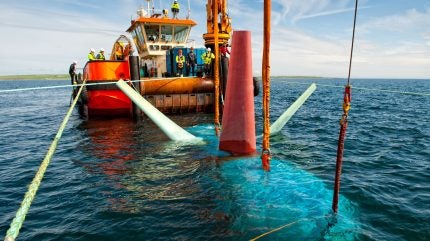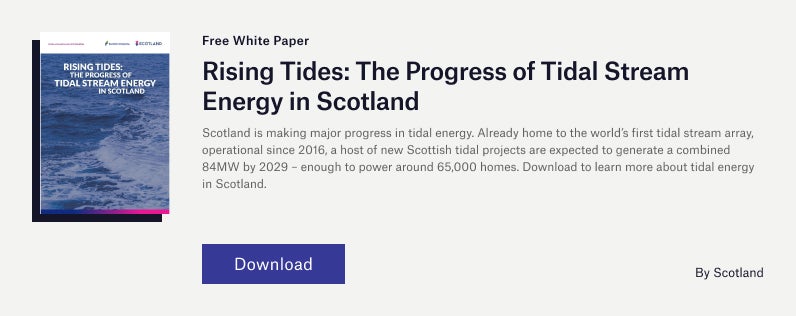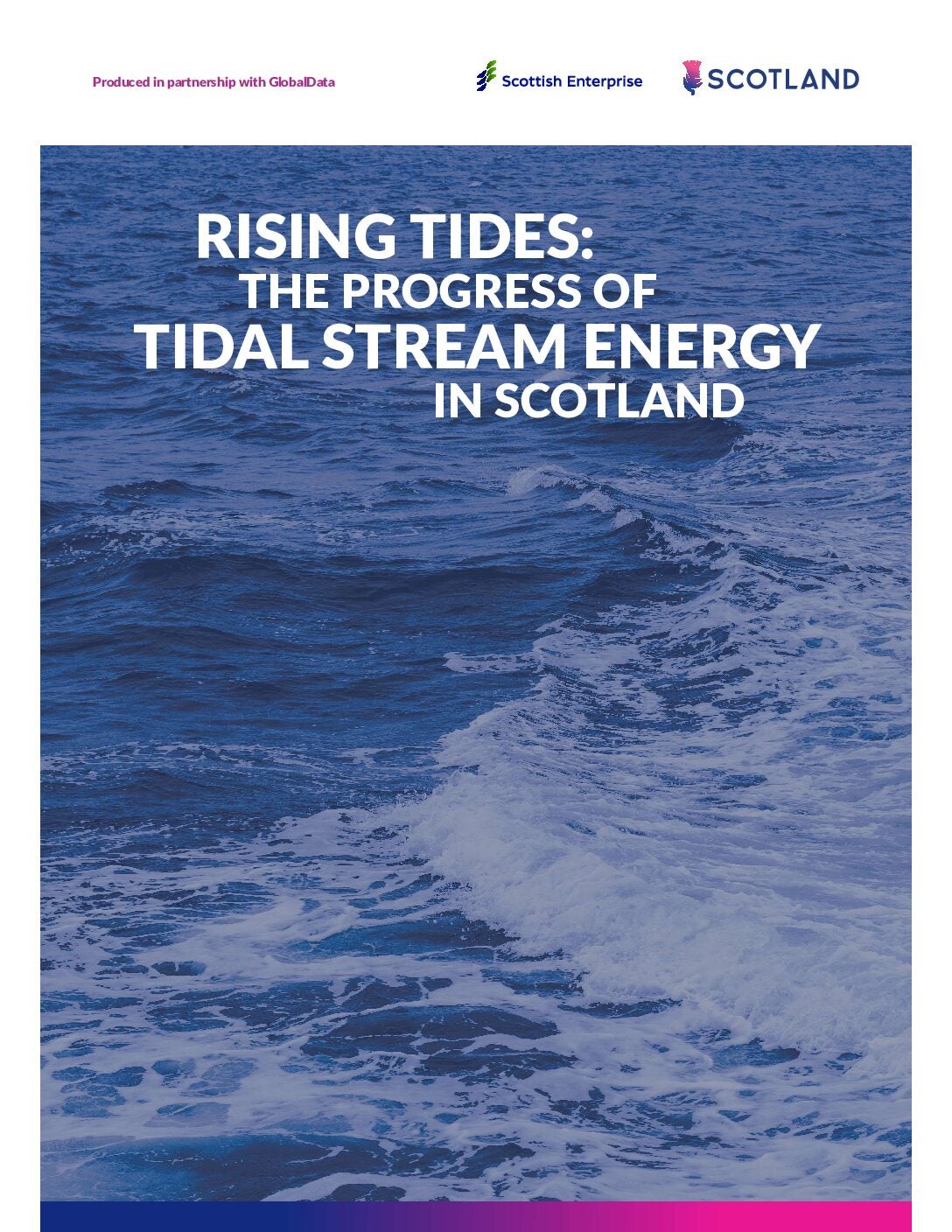
Tidal power could meet a substantial proportion of global energy demand, with some estimates that worldwide generation capacity could be as high as 1,200 terawatt-hours.
Despite tidal technology being well-understood and used on a small scale for hundreds of years, adoption rates on a commercial scale have not yet reached similar levels to other forms of clean energy generation.

The market for tidal is smaller than wind or solar, purely because of the comparable resource available. However, where tidal has a key advantage is in its predictability.
Leading the way for tidal is Scotland, which has already developed international expertise in this emerging clean energy sector. The country is home to the world’s first tidal stream array, with an industry ambition to have 700MW of installed generation capacity by 2035.
“We have the technology development companies, the resources, the projects, the sites. We have most of what we need to grow a successful industry,” says Matthew Finn, European Marine Energy Centre (EMEC) commercial director.
Testing and proving tidal stream technologies
A major barrier to tidal energy is that many developers are still refining their technologies, with variations between tidal turbine design and functionality. The lack of standardisation means that establishing a supply chain is a particular challenge. Unlike offshore wind, tidal stream still needs to scale up. As a result, the short-term risk profile is still quite high.
These technical hurdles are being addressed at EMEC, based in Stromness, Orkney. Established in 2003 by the UK Government and recipient of approximately £42m in funding from a range of sources, EMEC is a hugely influential organisation internationally in the development of tidal and wave energy technologies. If there is tidal technology in operation around the world, there is a strong likelihood that EMEC has been involved at some stage of the development process. Crucially, the tidal currents in Orkney are among the strongest in the world.
“When technologies come to EMEC, we focus on putting the support in place alongside our established infrastructure to ensure developers can prove their machines at scale. We are set up as an accredited test site – the only one for ocean energy in the world – so we can provide an independent analysis of device performance,” adds Finn. “This then feeds into investor due diligence.”
EMEC can also claim to be the first facility in the world to have produced green hydrogen from tidal energy powering an electrolyser. Experiments started in 2016 and offer a potential solution to the storage issue commonly associated with renewables.
“This is very much the place to try things, experiment, see what works and what doesn’t,” adds Finn.
Addressing issues with tidal stream development
As with most new industries, particularly energy, costs are a major barrier. Using facilities at EMEC allows tidal developers to save costs and de-risk new technologies.
EMEC can help demonstrate components such as cables and substations, as well as gain consent for future projects. Another core focus at EMEC is optimising data collection to demonstrate to governments the value of the tidal energy sector.
“EMEC is always here trying to push things on and trying to keep government engaged in the sector because it has got so much potential,” adds Finn.
A further difference between tidal and other renewables is the number of components and materials produced in the UK, which bodes well for the future supply chain and presents export opportunities.
“The amount of UK content is really high. We are seeing 80% plus, which is significant,” says Finn. “We are also seeing projects that now want to deploy multiple machines,” he adds. “That is really going to show cost reduction, which will then unlock the full potential sector.”
EMEC is also monitoring the effect of tidal technologies on marine life. So far, there is little evidence to suggest significant negative impacts. There may even be natural synergies that work in tidal energies’ favour as the industry develops continual monitoring, as well as the improvement of monitoring methodologies.
“We have been monitoring interactions with wildlife in various forms for almost 20 years,” adds Finn. “We have yet to see any kind of serious negative impact. That doesn’t mean that we don’t need to look though.
“We need to build up the evidence, particularly as the sector scales up, but my hope is that these technologies work in harmony with the environment. Ultimately, we will see a number of positive benefits coming through.”

Leading tidal steam energy towards commercialisation
Scotland is home to companies and projects attracting global attention for their expertise in tidal energy. One leading project is MeyGen, owned by SAE Renewables, which is developing the world’s largest tidal stream project with a capacity of 398MW.
The project is split into phases, with work already progressing. The 6MW phase one is now operational and includes four 1.5MW tidal turbines. Phase 1A is in operation and has a strong claim to be the world’s first commercial tidal steam array, operating under a debt finance structure.
Phase two is a considerable step up at 59MW, with a target of commissioning in 2027 for the first 28MW. A contract for the difference was awarded in 2022 in Allocation Round 4 worth £178.54 per megawatt-hour. The target delivery date for the remaining capacity in phase two is 2029, with planning underway for the wider scope of work.
In an industry of nascent technologies, MeyGen’s three-blade turbines have the crucial operating hours on the clock. MeyGen turbines have been in subsea operation since 2016, with the longest-running turbine clocking up more than five years of continual subsea generation. As of September 2024, the array has delivered more than 68 gigawatt-hours of predictable electricity to the UK grid – accounting for almost two-thirds of all tidal stream power generated globally to date.
“We want to deploy 200MW at MeyGen and we want to see 500MW in Scotland. That is what MeyGen is working to deliver,” says Fraser Johnson, O&M manager at MeyGen.
“If you can deploy 500MW of tidal stream generation in the Pentland Firth delivering a totally predictable 500MW, you can start looking at baseload power,” he adds. “And you then have the ability to provide that into the grid in a totally predictable manner.”
Yet Fraser is under no illusion about the scale of the challenge facing the industry and is acutely aware of previous false dawns for tidal.
What could make the difference this time is the combination of net-zero targets growing ever closer, continuous backing from the Scottish Government, and a new government in Westminster that has earmarked tidal for a possible share of an extra £270m in funding.
Tidal projects of different scales in Scotland
The EU has set a target for 2030 to have 1GW of marine energy installed, which will increase to 40GW by 2050. Given the potential capacity available, tidal is understood to make up a high proportion of this. Two important EU-backed tidal projects run by Scottish companies are due to be demonstrated at EMEC in the coming years.
One is the 9.6MW EURO-TIDES project by Orbital Marine Power, starting in 2027, which will upscale Orbital’s floating tidal energy technology. The second is the 4MW SEASTAR project by Nova Innovation, which will feature an array of 16 tidal stream turbines – the highest concentration at any tidal site worldwide. It builds on the success of Nova Innovation’s project in Shetland that powered an electric vehicle charger with an array of tidal stream turbines.
Yet it is not just large-scale projects that are underway in Scotland – there are also examples of smaller projects focused on delivering power to coastal communities.
Glasgow-based Flex Marine Power has been awarded £1.87m in government funding to develop its SwimmerTurbine, a 50kW tidal turbine capable of powering approximately 40 homes. The company is working to bring the social, environmental, and financial benefits of tidal energy to communities and small businesses.
The combination of innovation and expertise all position Scotland as a leading international destination to harness the potential of tidal energy.
“The endgame is to see tidal projects deployed all over the world as we have huge natural resources in Asia, areas in Europe – particularly in France. There are also some key markets in Canada – the Bay of Fundy is a huge tidal resource – and areas of North America and Alaska,” adds Finn. “It will be great to see Scottish technology deployed in all these locations.”
To learn more about tidal energy in Scotland, download the document below.



